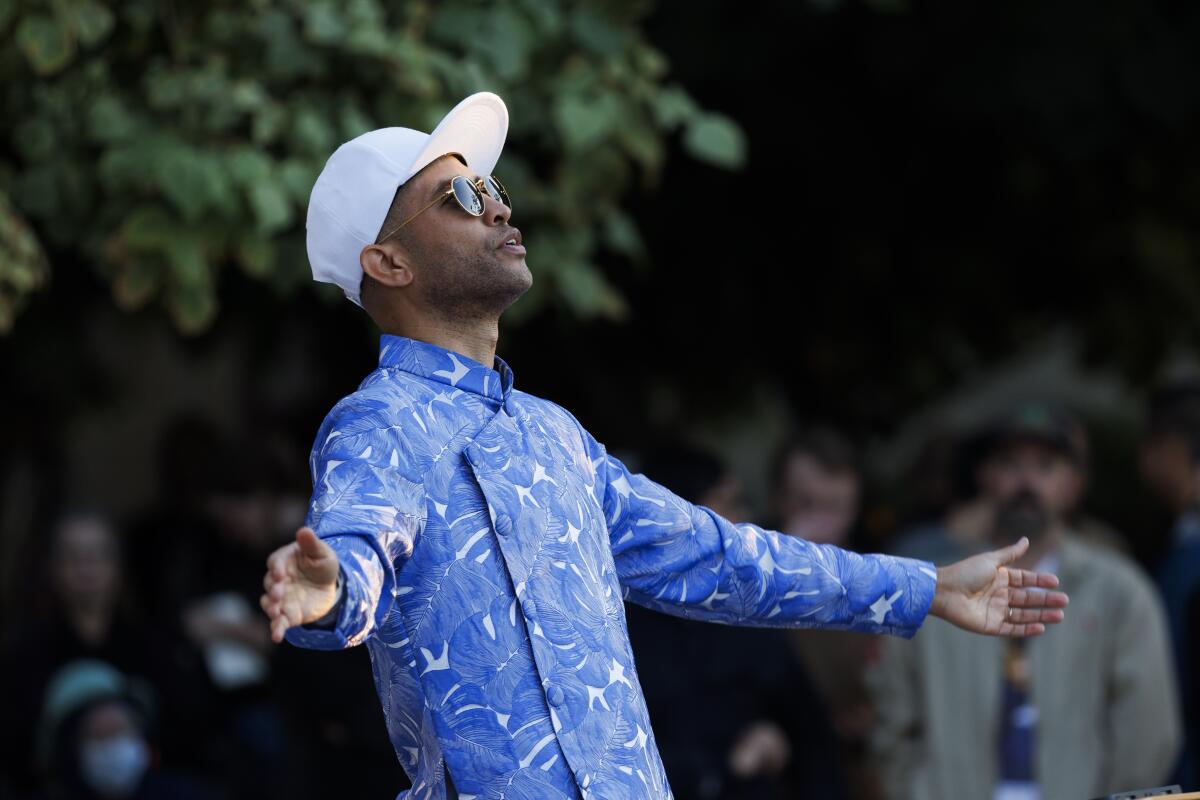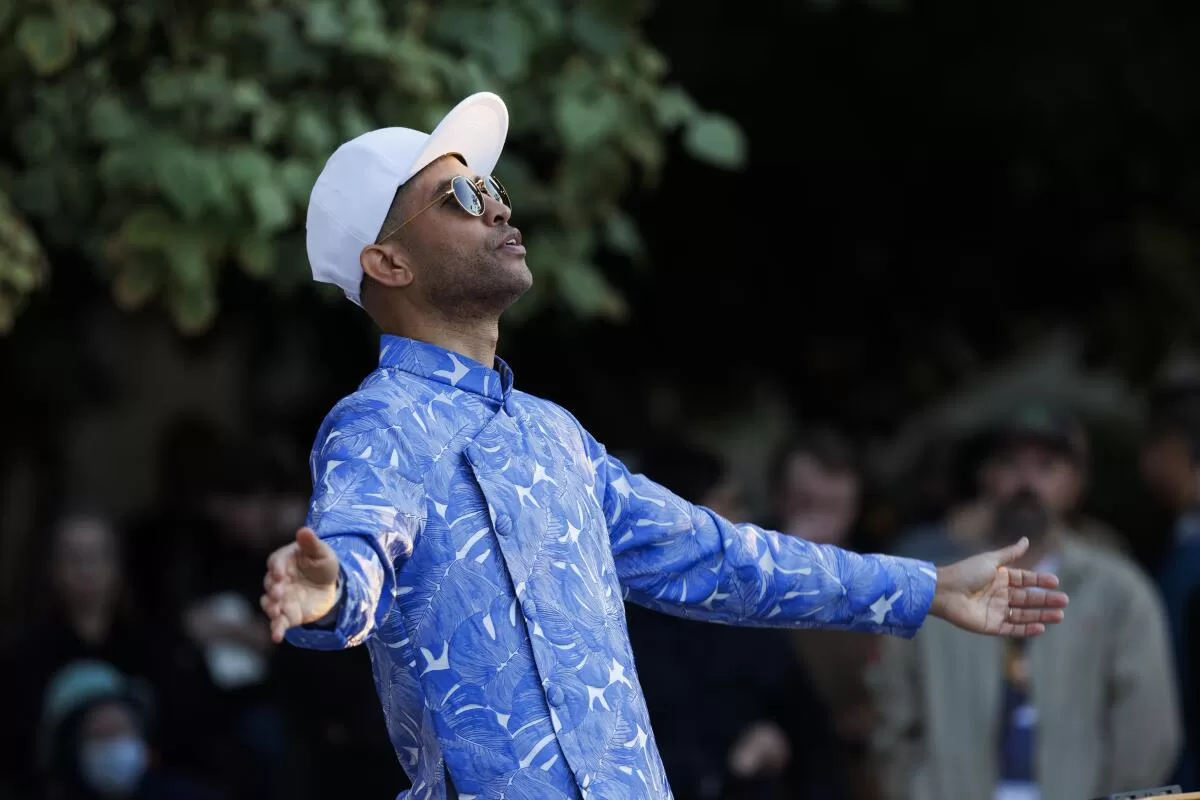“Noon to Midnight,” the Los Angeles Philharmonic‘s annual marathon, welcomes families, arts trendsetters, the dedicated new-music crowd and the merely curious to every nook and cranny of Walt Disney Concert Hall. The $12 ticket — less than just about anything on the food trucks out front or most drinks in the beer garden — breaks down to a buck an hour.
Visit a farmers market Saturday morning and then show up at Disney Hall at lunchtime, and the transition feels seamless. The musical vendors on display are locavore new-music ensembles. You wander around and check out whatever is in season.
This year, however, was different. For the first time, the L.A. Phil selected a curator, composer Ellen Reid, whose music often relates to place and who loves composing sound walks. She focused on new work that in some way employs field recordings or evokes our environment as it is changing.
“Climate issues are too big for music to solve,” Reid admitted in one of the talks that were part of the event. But what composers can do in myriad ways is to document, through sounds, what the world is like today as well as to interact with or manipulate sounds that heighten our awareness of nature.

Derrick Skye conducts an ensemble in the Blue Ribbon Garden behind Disney Hall as part of the L.A Phil’s “Noon to Midnight.”
(Carlin Stiehl / For The Times)
Inside various parts of Disney Hall as well as outside it, the program delivered 23 formal concerts (often two or three at the same time), including many world premieres. But like nature, “Noon to Midnight” defied categorization. What’s new and what’s not is a continuum. There were improvisations, installations, adaptations and novel collaborations among musicians and artists and media, with Mother Nature ever in the picture.
One great advantage to this inordinate model is rejection of FOMO mania. You can’t help but miss out on something, and miss out big time. Do you browse and graze and get a big picture of the musical multitudes? Do you make a plan and try to catch a few musts? What about food, drink, rest?
Only the concerts in the main hall offered comfort. The chairs were removed in BP Hall for experimental work, which meant sitting on the floor or standing (ushers stopped us from leaning on the walls). Concerts in the chilly outdoor amphitheater meant bundling up. In this way, music becomes the environment, similar to a long day in the country. Highlights seemed less important than encounters that added up to an overall experience. It’s not what you heard or how much; it was how hearing and noticing can change your chemistry.
For the opening event in BP Hall, Michael Pisaro-Liu created complex, almost dangerously alluring electronic drones messing with sine waves oscillating off field recordings he had made around L.A. The more you listen, the deeper the sound gets inside you.
Andrew Norman’s “A Companion Guide to Rome,” nine movements for string trio, each an impression of a church, got a delirious performance by different groupings of Delirium Musicum in the main hall. This virtuosic group also gave the first performance of Andrew Yee’s “Trees of Greenwood” in its full string orchestra version, with soprano Laurel Irene intoning the names of trees like an angelic voice from beyond, as though reminding us of members of a long-lost forest.
Andrew McIntosh’s “Learning” led off a Wild Up concert in BP Hall, with a percussionist communing intriguing small sounds with those from field recordings made in Angeles National Forest. Outside in the Keck Amphitheater, John Eagle let his memory be the unreliable guide in “inside-outside,” his field recordings turned into scratchy, deep rumbling drones that merited an excited response from the edgy Isaura String Quartet. Back in BP, the Calder Quartet brought exquisite warmth to the sunny, slippery melodic lines in Missy Mazzoli’s “Death Valley Junction.”

The RedKoral trio performs outside Disney Hall, in the Keck Amphitheater, as part of “Noon to Midnight.”
(Carlin Stiehl / For The Times)
Anne LeBaron’s “My Beloved Spectra” uses electronically altered extra-terrestrial NASA field recordings to bring us back down to Earth with the heavenly RedKoral trio’s violin, viola and harp. Soundscape environmental composer Annea Lockwood dived deep into gripping, gurgling water sounds that were electronically enhanced and got the joint jumping with her piano percussion duo “Jitterbug,” performed by Vicki Ray and Wesley Sumpter.

Vicki Ray performing “Jitterbug.”
(Carlin Stiehl / For The Times)
Long lines of attendees waited for Reid’s own contribution, “Oscillations: 100 Years and Forever,” originally written for the L.A. Phil centennial. Vocal soloists, chorus and projection created an immersive love letter to L.A., then and now. For 20 minutes, Reid made one believe in a city worth protecting.
This was but a small sampling of a vast day and night, building up to a grand event in the main auditorium: Doug Aitken’s “Landscape,” the elephant in the room presumably waiting to eclipse all others. “Noon to Midnight” was originally created to wrap around a Green Umbrella concert by the L.A. Phil New Music Group. It remains the one program that requires a separate ticket.
In this case, a major collaboration between the orchestra and the L.A. Master Chorale accompanied Aitken’s 65-minute video. “Lightscape” seemed the hottest ticket. It had been long sold out. Many showed up just for “Landscape.”
I don’t think I’ve ever encountered a more disgruntled audience in the four decades of Green Umbrella concerts. One person after another after another came up to me to complain about what appeared to be a glossy commercial filled with beautiful people, a beautiful mountain lion, beautiful houses, beautiful nature. A beat-up old pickup truck had glamour. A break dancer made an Amazon factory a snappy, a happy place for field recording.
The score — with bits and pieces of Philip Glass, Terry Riley, Steve Reich, Meredith Monk, Beck and others, including Aitken — was put together by the artist and Master Chorale Artistic Director Grant Gershon. For the live performance, members of the L.A. Phil New Music Group and the Master Chorale, conducted by Gershon, lip- and instrument-synced amazingly to the film.
“Lightscape” will surely be more at home as a swanky seven-screen installation next month at the Marciano Art Foundation. In the live performance, the musicians collided with a soundtrack of overly amplified spoken voices and environmental sounds. Yet musicians made magic, instrumentalists and singers finding enchantment in meeting every environmental challenge they faced, filling what might otherwise be empty beauty with wondrous substance. No field recording could hope for more.

Wesley Sumpter at “Noon to Midnight.”
(Carlin Stiehl / For The Times)
